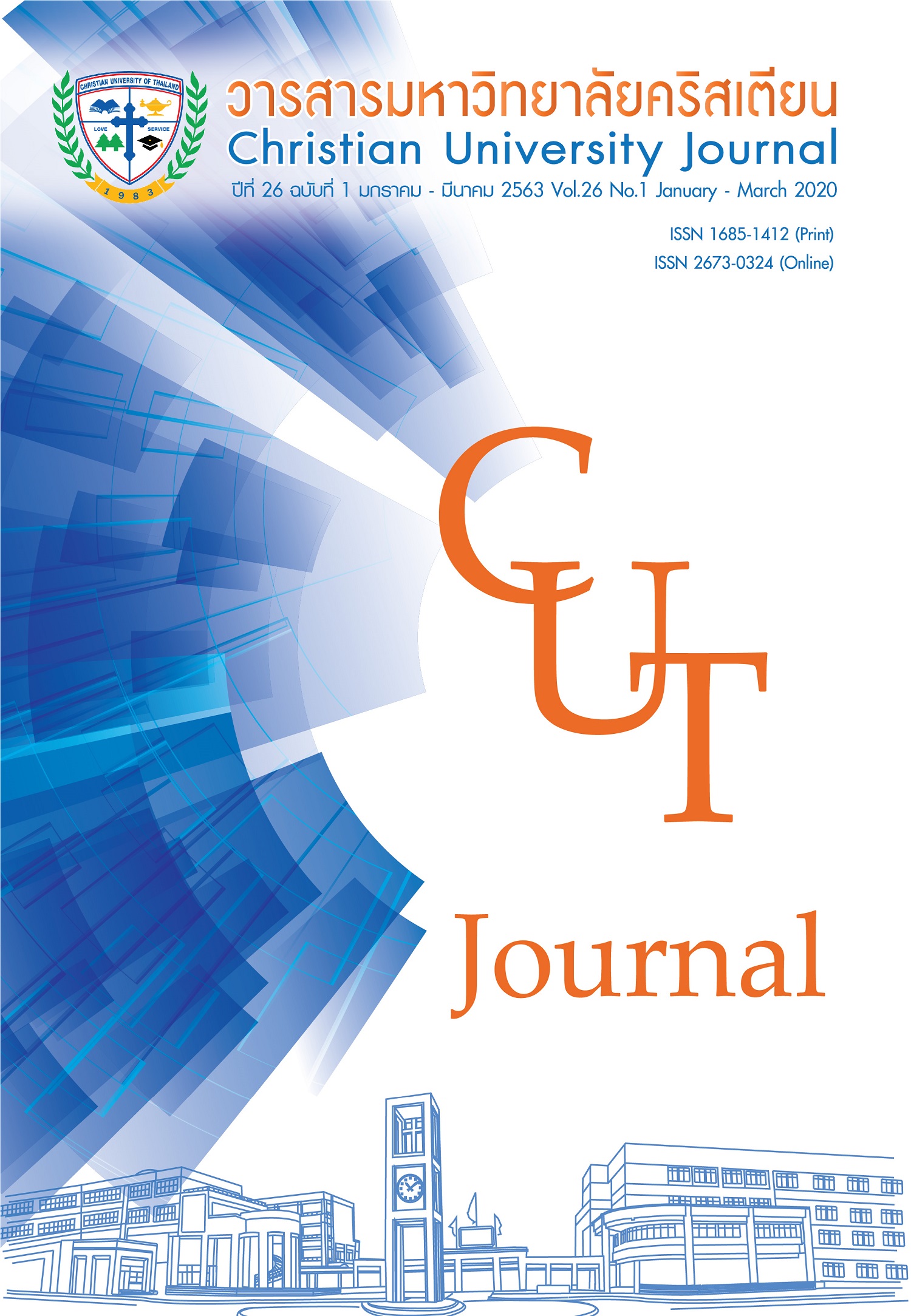ผลของการใช้ภาพเคลื่อนไหวสามมิติต่อผลสัมฤทธิ์ทางการเรียนวิชากายวิภาคศาสตร์ ระบบหัวใจของนักศึกษาวิทยาศาสตร์สุขภาพ
คำสำคัญ:
ระบบจำลองสามมิติ, ผลสัมฤทธิ์ทางการเรียน, กายวิภาคศาสตร์บทคัดย่อ
การศึกษาครั้งนี้เป็นการศึกษาแบบ quasi-experiment research มีวัตถุประสงค์เพื่อเปรียบเทียบผลสัมฤทธิ์ทางการเรียนวิชากายวิภาคศาสตร์ระบบหัวใจของนักศึกษาวิทยาศาสตร์สุขภาพระหว่างสื่อการเรียนการสอนที่แตกต่างกัน 3 วิธี กลุ่มตัวอย่างคือนักศึกษาจำนวน 92 คน แบ่งกลุ่มตัวอย่างออกเป็น 3 กลุ่ม ตามวิธีการเรียนการสอนคือ 1) การใช้โมเดลจำลองหัวใจมนุษย์ 2) การใช้หัวใจหมู และ 3) การใช้ระบบจำลองสามมิติระบบหัวใจมนุษย์ มีการทดสอบก่อน และหลังการเรียนการสอน ในแต่ละวิธี สถิติที่ใช้ในการวิเคราะห์คือ ข้อมูลพื้นฐานของกลุ่มตัวอย่างวิเคราะห์โดยใช้สถิติเชิงบรรยาย การเปรียบเทียบคะแนนระหว่าง 3 วิธีใช้สถิติ one-way ANOVA และเปรียบเทียบคะแนนก่อนเรียนและหลังเรียนในแต่ละวิธีใช้สถิติ paired t-test ผลการวิจัยพบว่า ผลสัมฤทธิ์หลังการเรียนในกลุ่มที่เรียนโดยใช้ระบบจำลองสามมิติระบบหัวใจมนุษย์มีคะแนนสูงสุดเท่ากับ 8.60±1.27 คะแนน โดยทั้ง 3 กลุ่มมีระดับคะแนนหลังการเรียนเพิ่มขึ้นเมื่อเทียบกับคะแนนก่อนเรียนอย่างมีนัยสำคัญทางสถิติที่ (p-value < .01) ส่วนการเปรียบเทียบทั้ง 3 วิธีพบว่า กลุ่มที่เรียนด้วยระบบจำลองสามมิติระบบหัวใจมนุษย์มีความแตกต่างจากทั้ง 2 กลุ่มอย่างมีนัยสำคัญทางสถิติที่ระดับ .01 (p-value < .01) แต่เมื่อเปรียบเทียบระหว่างกลุ่มที่เรียนด้วยโมเดลจำลองหัวใจมนุษย์และกลุ่มที่เรียนด้วยหัวใจหมูไม่มีความแตกต่างกันอย่างมีนัยสำคัญทางสถิติ ดังนั้นจึงสามารถสรุปได้ว่าระบบจำลองสามมิติระบบหัวใจมนุษย์สามารถเพิ่มประสิทธิภาพการเรียนการสอนกายวิภาคศาสตร์ระบบหัวใจได้เป็นอย่างดี
เอกสารอ้างอิง
ชัชวาล วงศ์สารี. (2558). การสอนบนคลินิกในรายวิชาปฏิบัติการพยาบาลผู้ใหญ่สำหรับนิสิต Generation Z. วารสารวิทยาลัยพยาบาลบรมราชชนนี กรุงเทพ, 31(2), 130-140.
ณรงค์ กราสันเทียะ, ทวีศักดิ์ จินดานุรักษ์, และชำนาญ เชาวกีรติพงศ์. (2556). ผลการใช้สื่อภาพเคลื่อนไหว 3 มิติ ในการเรียนวิชาฟิสิกส์ที่มีต่อผลสัมฤทธิ์ทางการเรียนและเจตคติทางวิทยาศาสตร์ของนักเรียนชั้นมัธยมศึกษาปีที่ 5 โรงเรียนมารีย์วิทยา จังหวัดนครราชสีมา. วารสารศึกษาศาสตร์ มสธ., 6(2), 130-139.
ทรงวุฒิ ฉิมจินดา และณัฐพล โชติศรีศุภรัตน์. (2553). ผลสัมฤทธิ์การบูรณาการเทคโนโลยีบทเรียนอิเล็กทรอนิกส์สำหรับนิสิตชั้นปีหนึ่งระดับปริญญาตรี. ใน สมาคมฟิสิกส์ไทย (บ.ก.), การประชุม Siam Physics Congress SPC 2012 (น. 247-249). พระนครศรีอยุธยา, ประเทศไทย.
ธัญญลักษณ์ วจนะวิศิษฐ. (2553). ประสิทธิภาพของบทเรียนบนระบบเครือข่ายรายวิชากายวิภาคศาสตร์และสรีรวิทยา เรื่องระบบโครงกระดูกร่างกาย. วารสารการพยาบาลและการศึกษา. 3(1), 15-28.
รสรินทร์ เกรย์, อุมาภรณ์ ภัทรวาณิชย์, อักษราภัค หลักทอง, และ เจตพล แสงกล้า. (2559). คุณภาพชีวิตต่างวัยของผู้มีงานทำ. กรุงเทพมหานคร: เดือนตุลา จำกัด.
วิจารณ์ พานิช. (2555). การเรียนรู้ในศตวรรษที่ 21. สืบค้นจาก http://www.qlf.or.th/Home/Contents/417
อัจฉราวดี ศรียะศักดิ์, วารุณี เกตุอินทร์, สุวรรณี แสงอาทิตย์, และวิโรจน์ ฉิ่งเล็ก. (2554). การทดสอบประสิทธิภาพองบทเรียนคอมพิวเตอร์บนเครือข่ายอินเทอร์เน็ตเรื่อง“อุทกเศียร (Hydrocephalus)” สำหรับนักศึกษาพยาบาลศาสตร์ชั้นปีที่ 3. วารสารมหาวิทยาลัยนราธิวาสราชนครินทร์, 7(3), 91-103.
Ang, E.T., Sugand, K., Hartman, M., Seow, C.S., Bay, B.H., Abrahams, P. (2012).Singapore’s anatomical future: quo vadis?. Anatomical Sciences Education, 5(4), 234–240.
Chen, S. et al. (2017). The role of three-dimensional printed models of skull in anatomy education: a randomized controlled trail. Scientific Reports, 7, 1-11.
Custer, T., Michael, K. (2015). The Utilization of the anatomage virtual dissection table in the education of imaging science students. Journal of Tomography and Simulation, 1(1), 1-4.
Gunderman, R. B. (2008). Giving ourselves: the ethics of anatomical donation. Anatomical Sciences Education, 1, 217–9.
Kazoa, D. and Pilmane, M. (2017). Teaching and learning innovation in present and future of human anatomy course at RSU. Papers on Anthropology, 2, 44-52.
Hasan, T. (2011). Is dissection humane?. Journal of Medical Ethics and History of Medicine, 4(4), 1-4.
Schmitt, B., Wacker, C., Ikemoto, L., Meyers, F. J. and Pomeroy, C. (2014). A transparent oversight policy for human anatomical specimen management: the university of california, davis experience. Academic Medicine, 89, 410–4.
Trelease, R.B. (2016). From chalkboard, slides, and paper to e-learning: How computing technologies have transformed anatomical sciences education. Anatomical Sciences Education, 9(6), 583–602.



